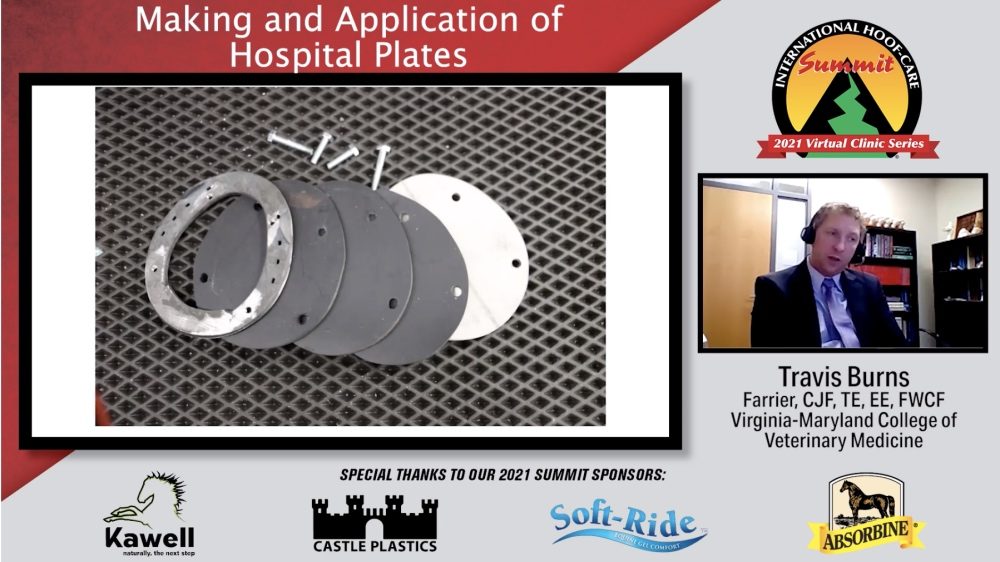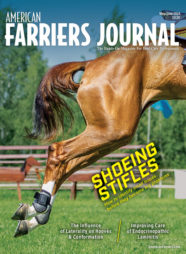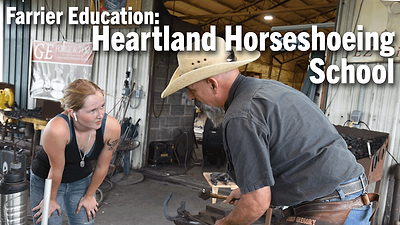Therapeutic cases often require creative shoeing solutions. One solution for horses in need of sole or hoof capsule protection is a hospital plate.
Travis Burns, the chief of Farrier Services at the Virginia-Maryland College of Veterinary Medicine, shares guidelines for selecting an applying hospital — or treatment — plates during the International Hoof-Care Summit — 2021 Virtual Clinic Series.
In his presentation “Making and Application of Hospital Plates,” Burns outlines indications for the appropriate use of hospital plates.
“There are many different indications for the use of a hospital plate,” Burns says. “Puncture wounds to the solar surface of the hoof is probably the most common use here at the hospital.”
Other cases that call for the use of a hospital plate include:
- Abscesses.
- Keratoma removal and resections.
- Septic P3 ostitis.
- P3 sequeestrum
- Laminitis, both acute and chronic.
- Canker.
- Hoof avulsions.
When applying a hospital plate, Burns typically uses a bandage to avoid contamination of the treated area.
“You can use a bar shoe to try to limit the gap, but there’s always a chance for dirt and debris to pack in between the junction of the shoe or in the palmar/plantar aspect of the frog and heel bulbs,” he says. “We still commonly incorporate a hospital plate with a bandage to reduce dirt, debris and microbes from infiltrating that area. A hospital plate is just a portion of the treatment plan. It probably shouldn’t be the only thing used for most cases.”
Burns has seen a variety of materials used to create the treatment plate including a wooden kitchen cutting board and even an aluminum traffic sign. However, the four most popular are the four-bolt aluminum plate, the Farley Plate, the Peek-a-Boo hospital pad and a urethane treaded plate.
Four-bolt Aluminum Plate
The advantages of using a four-bolt aluminum plate are materials are inexpensive and readily available, the bolt heads provide traction and it allows access to the entire solar surface of the hoof.
The disadvantages are the four bolts need to be removed, it increases the foot/limb height, the bolt heads can damage recovery stall floors, require the horse to stand on bolt heads on hard/firm surfaces and the plate must be fabricated.
Farley Plate
The advantages are the materials are inexpensive and readily available, it incorporates one bolt, there is no increase in foot/limb height and there is more bearing surface compared with the four-bolt system when a horse is on a firm surface.
The disadvantages are dirt and debris can enter the tongue portion of the plate that secures it to the toe of the shoe, it’s not ideal for when the treatment area is the palmar frog as the bar can cover, the plate must be fabricated and traction on various surfaces can be reduced.
Peek-a-Boo Hospital Pad
The advantages of applying a Peek-a-Boo or a commercially available hospital pad that is manufactured by Castle Plastics, Grand Circuit and others include inexpensive and readily available materials from supply shops and distributors and they don’t increase hoof and limb height more than a typical shoe and pad combination.
The disadvantage is they allow access to only a certain portion of the solar surface of the hoof.
Urethane Treaded Plate
Burns frequently uses a modified four-bolt system from SoundHorse Technologies called the Series III Treaded Plate. The advantages include great traction on many surfaces as a result of the use of urethane; the bolt heads are flush with the urethane, reducing the risk of injury for the horse and damage to the facility from raised bolt heads; the ability to grind the urethane to reduce breaker in any direction; and it’s aesthetically appealing.
The disadvantages include that the material is more expensive and application can require extra tools.
For more tips on making and applying hospital plates, be sure to watch Burns’ complete presentation. If you’re not registered for the International Hoof-Care Summit — 2021 Virtual Clinic Series and would like to watch Burns’ presentation or 17 other informative Therapeutic Shoeing sessions in February, you can do so here. Each month, the IHCS will tackle a different hoof-care theme. By registering today, you will have access to February’s sessions, as well as those that follow through September. In addition, you will be automatically signed up to attend live online panel discussions, as well as live question-and-answer sessions.








Post a comment
Report Abusive Comment